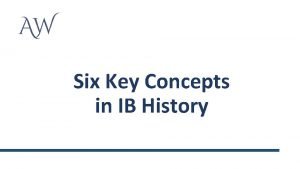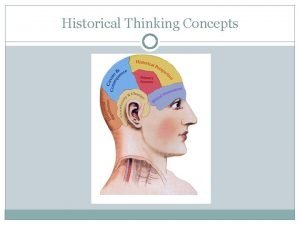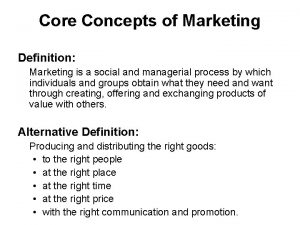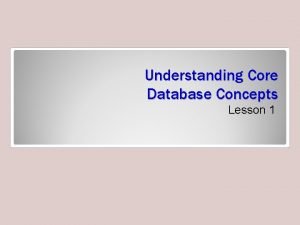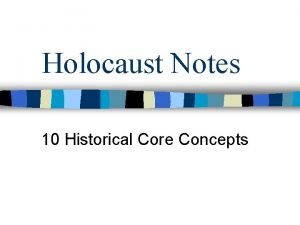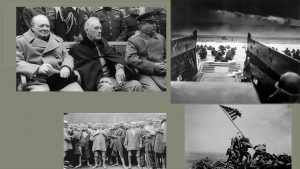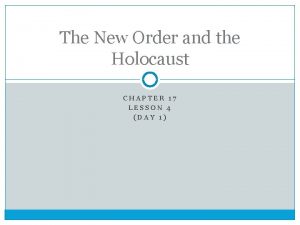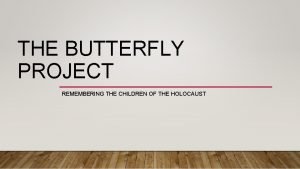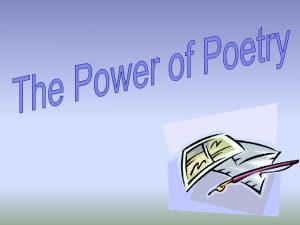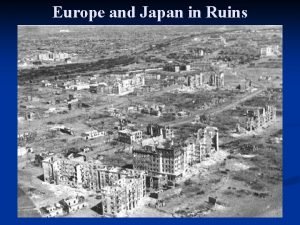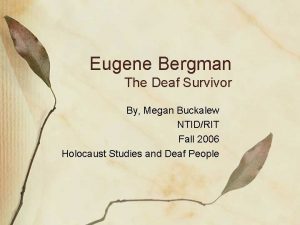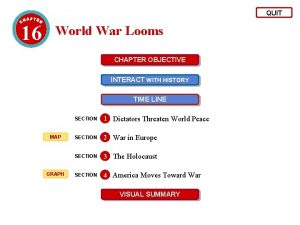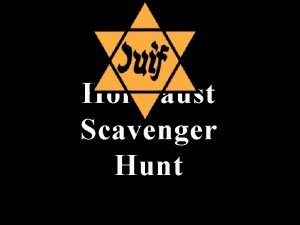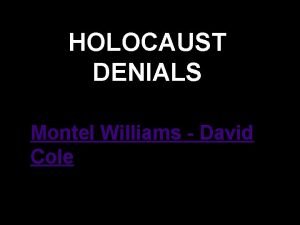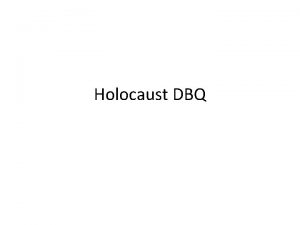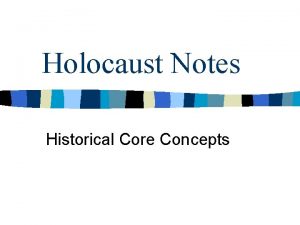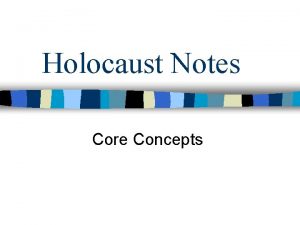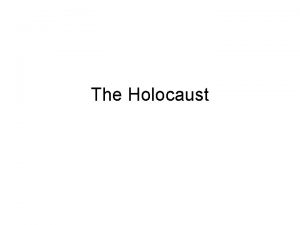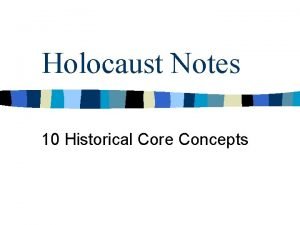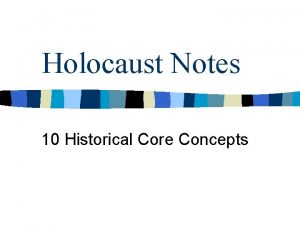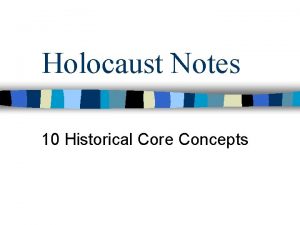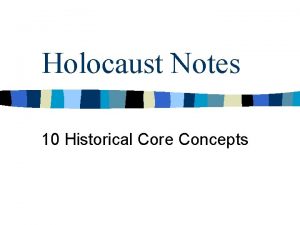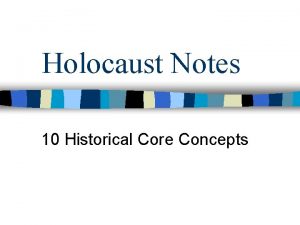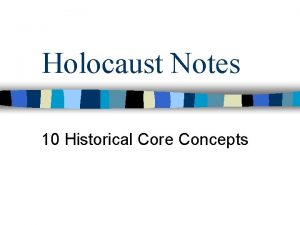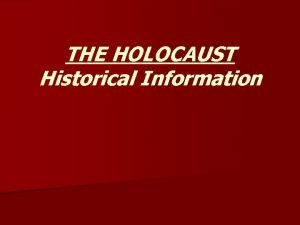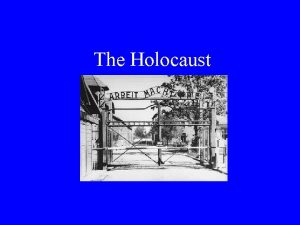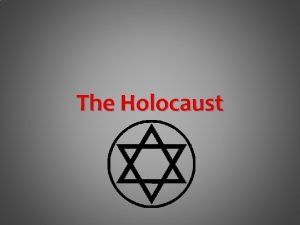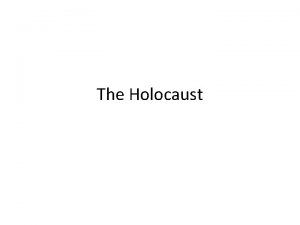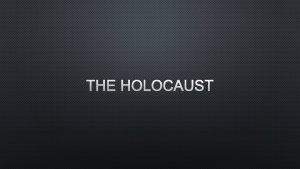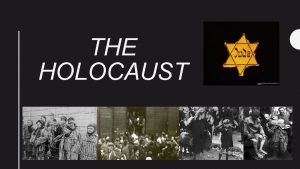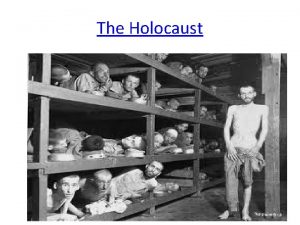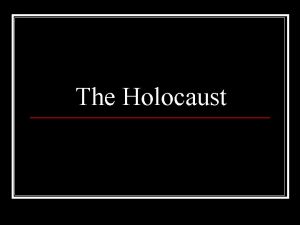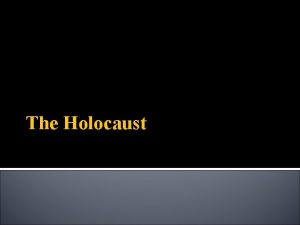Holocaust Notes 10 Historical Core Concepts 10 Historical





























- Slides: 29

Holocaust Notes 10 Historical Core Concepts

10 Historical Core Concepts 1. 2. 3. 4. 5. Pre-War Antisemitism Weimar Republic Totalitarian State Persecution 6. U. S. and World Response 7. The Final Solution 8. Resistance 9. Rescue 10. Aftermath

Pre-War Group portrait of members of the Jewish community of Sighet in front of a wooden synagogue. 1930 -1939.

Pre-War Jews were living in every country in Europe before the Nazis came into power in 1933 n Approximately 9 million Jews n Poland the Soviet Union had the largest populations n Jews could be found in all walks of life: farmers, factory workers, business people, doctors, teachers, and craftsmen n

Antisemitism n Jews have faced prejudice and discrimination for over 2, 000 years. n Jews were scapegoats for many problems. For example, people blamed Jews for the “Black Death” plague that killed thousands in Europe during the Middle Ages.

Anti-semitism n In the Russian Empire in the late 1800 s, the government incited attacks on Jewish neighborhoods called pogroms. Mobs murdered Jews and looted their homes and stores.

Antisemitism Political leaders who used antisemitism as a tool relied on the ideas of racial science to portray Jews as a race instead of a religion. n Nazi teachers began to apply the “principles” of racial science by measuring skull size and nose length and recording students’ eye color and hair to determine whether students belonged the “Aryan race. ” n


Weimar Republic n After Germany lost World War I, a new government formed and became the Weimar Republic. n Many Germans were upset not only that they had lost the war but also that they had to repay (make reparations) to all of the countries that they had “damaged” in the war.

Post WWI n Treaty of Versailles: – Germany had to assume all responsibility for the war. – Their military was reduced – Forced to join forces with neighboring countries – Make reparations to countries they had damaged in the war

Weimar Republic The total bill that the Germans had to “pay” was equivalent to nearly $70 billion. n The German army was limited in size. n Extremists blamed Jews for Germany’s defeat in WWI and blamed the German Foreign Minister (a Jew) for his role in reaching a settlement with the Allies. n

Weimar Republic The German mark became worth less than the paper it was printed on— hyperinflation occurred. n Nearly 6 million Germans were unemployed. n

Totalitarian State Totalitarianism is the total control of a country in the government’s hands n It subjugates individual rights. n It demonstrates a policy of aggression. n

Totalitarian State In a totalitarian state, paranoia and fear dominate. n The government maintains total control over the culture. n The government is capable of indiscriminate killing. n During this time in Germany, the Nazis passed laws which restricted the rights of Jews: including the Nuremberg Laws. n

Totalitarian State The Nuremberg Laws stripped Jews of their German citizenship. They were prohibited from marrying or having sexual relations with persons of “German or related blood. ”

Totalitarian State Jews, like all other German citizens, were required to carry identity cards, but their cards were stamped with a red “J. ” This allowed police to easily identify them.

Totalitarian State The Nazis used propaganda to promote their antisemitic ideas. n One such book was the children’s book, The Poisonous Mushroom. n

Persecution The Nazi plan for dealing with the “Jewish Question” evolved in three steps: 1. Expulsion: Get them out of Germany 2. Containment: Put them all together in one place – namely ghettos 3. “Final Solution”: annihilation

Persecution Nazis targeted other individuals and groups in addition to the Jews: n n n Gypsies (Sinti and Roma) Homosexual men Jehovah’s Witness Handicapped Germans Poles Political dissidents


Persecution Kristallnacht was the “Night of Broken Glass” on November 9 -10, 1938 n Germans attacked synagogues and Jewish homes and businesses n

Kristallnaucht Planned by the German government and executed by the public, including Hitler’s Youth. n Was spurred by the murder of a German officer by a Jewish man in France. n

U. S. and World Response n The Evian Conference took place in the summer of 1938 in Evian, France. n 32 countries met to discuss what to do about the Jewish refugees who were trying to leave Germany and Austria. n Despite voicing feelings of sympathy, most countries made excuses for not accepting more refugees.

U. S. and World Response n Some American congressmen proposed the Wagner-Rogers Bill, which offered to let 20, 000 endangered Jewish refugee children into the country, but the bill was not supported in the Senate. n Antisemitic attitudes played a role in the failure to help refugees.

U. S. and World Response 1. The SS St. Louis, carrying refugees with Cuban visas, were denied admittance both in Cuba and in Florida. After being turned back to Europe, most of the passengers perished in the Holocaust.


Final Solution n The Nazis aimed to control the Jewish population by forcing them to live in areas that were designated for Jews only, called ghettos. n Ghettos were established across all of occupied Europe, especially in areas where there was already a large Jewish population.

Final Solution Many ghettos were closed by barbed wire or walls and were guarded by SS or local police. n Jews sometimes had to use bridges to go over Aryan streets that ran through the ghetto. n

Final Solution n Life in the ghettos was hard: food was rationed; several families often shared a small space; disease spread rapidly; heating, ventilation, and sanitation were limited. n Many children were orphaned in the ghettos.
 Historical thinking concepts meaning
Historical thinking concepts meaning Ib history key concepts
Ib history key concepts Historical thinking concepts
Historical thinking concepts Victorian curriculum history
Victorian curriculum history A company's resources and capabilities represent
A company's resources and capabilities represent 5 core customer and marketplace concepts
5 core customer and marketplace concepts Core concepts of management
Core concepts of management The core concepts of marketing
The core concepts of marketing Understanding core database concepts
Understanding core database concepts Core concepts
Core concepts Core concepts of accounting information systems
Core concepts of accounting information systems Core payroll concepts
Core payroll concepts Historical notes handmaid's tale
Historical notes handmaid's tale Inner core and outer core
Inner core and outer core Earth mantle definition
Earth mantle definition What are the 3 main layers of the earth? *
What are the 3 main layers of the earth? * Core rigidities
Core rigidities Facteur g
Facteur g Totalitarianism
Totalitarianism The new order in europe lesson 4
The new order in europe lesson 4 Butterfly project examples
Butterfly project examples Disaster acrostic poem
Disaster acrostic poem Holocaust acrostic poem answers
Holocaust acrostic poem answers Three ways u.s. occupation changed japan
Three ways u.s. occupation changed japan David bergman holocaust
David bergman holocaust Chapter 16 section 3 the holocaust answer key
Chapter 16 section 3 the holocaust answer key Upstanders and bystanders during the holocaust
Upstanders and bystanders during the holocaust Holocaust internet scavenger hunt answer key
Holocaust internet scavenger hunt answer key Einsatzgrupen
Einsatzgrupen Holocaust definition ap world history
Holocaust definition ap world history

